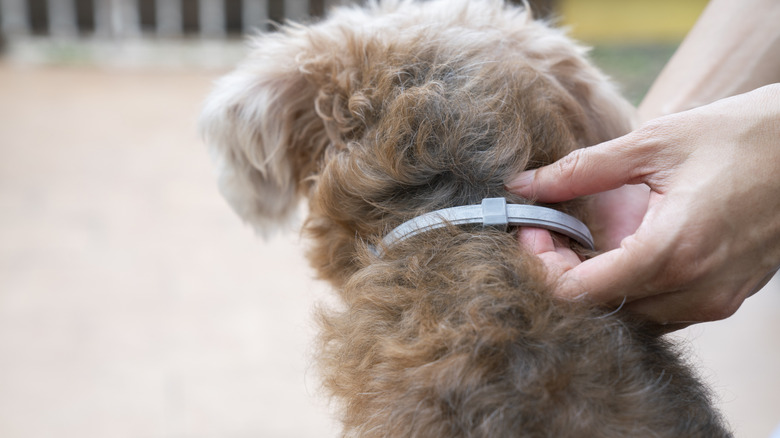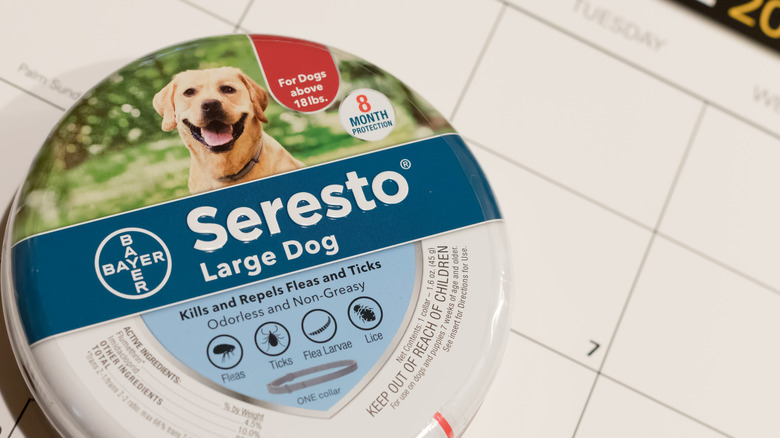The Truth About Flea Collars For Dogs
Fleas can be troublesome for pets and their owners, so it's important to learn all about fleas when preventing and getting rid of them on your pet and in your home. Part of the battle involves placing your dog on a year-round flea preventive, such as a flea collar. Just like any other parasite-killing product, there's some fine print to consider. Flea collars can be dangerous and for them to be effective, you have to follow the instructions. In addition, you should be mindful of water exposure and proper fit, know the active ingredients, and be aware of counterfeit collars.
Many pet parents opt for flea collars over other options because they offer protection for a significantly longer period of time. For example, many topical treatments must be applied monthly for continuous protection, but some flea collars can last up to eight months. Flea collars also typically don't require a prescription, and you don't have to deal with greasy fur from topicals.
Despite these benefits, it's important to consider other factors associated with flea collars before deciding if they're right for your dog, including the negative ones. Always read the instructions and product descriptions to ensure optimal safety and effectiveness, and contact your veterinarian or the collar manufacturer if you have any questions.
Flea collars can be hazardous
Most flea collars protect dogs from fleas and other parasites with the use of pesticides, but they can cause side effects ranging from mild to severe. In the "mild" category, some online reviewers have reported reddened skin on their dog directly under where the collar sits. Elanco's Seresto flea collar leaflets confirms this as a potential side effect, along with slight hair loss, both of which can last up to two weeks.
In the "severe" side effect category, some flea collars have received thousands of complaints of conditions ranging from injuries, seizures, and even death after their dogs used them. However, veterinary professionals and Elanco representatives suspect a connection between these negative reports and counterfeit collars designed to look like authentic Seresto collars — which is why it's always best to confirm you're buying a legitimate product.
Along with side effects, flea collar product information typically includes precautionary statements. Disregarding these dos and don'ts could result in injuries or a medical emergency. Just as with any other pesticide, flea collars should be kept away from mouths and eyes. You should also remember to wash your hands thoroughly with soap and water after handling one.
Excessive water exposure can reduce flea collar efficacy
In general, most flea collars claim to be water resistant, but not waterproof. This means that regularly submerging one in water could eventually affect how well they protect against fleas, or reduce the length of the protection. If your dog doesn't like to swim, you won't have to worry about excessive water exposure. Some owners bathe their dogs weekly or allow them to swim regularly without thinking twice about their flea collars. The problem is that not all flea collars offer the same water resistance.
Some collars claim to be water-resistant and still effective, even after a shampoo bath, swim, or rain exposure, but with the caveat that dogs should only be bathed monthly. In addition, flea protection duration could drop by a few months for dogs that swim once a month or more. Under normal circumstances with minimal water exposure, select flea collars can last for up to eight months.
A proper fit is important for flea collar effectiveness and safety
A common mistake that dog owners make with flea collars involves improper fitting. Some secure it too tightly while others don't secure it tightly enough. As a rule of thumb, the collar should fit snugly, but you should still be able to place a few fingers between it and your dog's neck. You should also trim a flea collar if it extends more than one inch beyond the loop, unless you have a puppy that's still growing.
If the collar fits too snugly, it can create a strangulation risk for your pet. Collar burn in dogs is another potential danger that can increase the chances of skin irritation and hair loss at the site of the collar. If the collar fits too loosely, the ingredients will not be able to penetrate your dog's skin as effectively as a tighter-fitting collar. This could lower the flea protection level, which means you may see an increase in fleas on your pet.
It's also important to check the fit of your dog's flea collar regularly. Sometimes, a collar can loosen or tighten over time for different reasons, so make adjustments as needed. This is especially important if you have a growing puppy or if you have a dog that tends to scratch around their neck.
Not all flea collars offer the same level of flea control
Seresto is one of the most popular flea collars for dogs, but there are a few other well-known brands to choose from, such as PetArmor, Adams, and Hartz. While collars designed to kill fleas typically use some type of insecticide, they don't all use the same active ingredients. This means they don't all control fleas in the same way.
The active ingredients in one of the leading dog flea collar brands are imidacloprid and flumethrin, while other brands contain deltamethrin or methoprene — or both — as the active ingredient. All of these insecticides impair a flea's central nervous system, which eventually leads to death. However, the imidacloprid and flumethrin combination is generally considered more effective than the others, due to its ability to provide better long-term flea control and greater success in killing fleas at different life stages.
If you're seeking a collar with natural ingredients, you have several brands and options to choose from in that category as well. These collars primarily use steam-distilled natural essential oils (cedarwood, lemongrass, peppermint, rosemary) to repel fleas. However, they make no mention of killing fleas, so they may not be as effective for homes that are already infested.
Some flea collars are counterfeit
Seresto is the most recommended flea collar brand by veterinarians. It's also the best-selling and most expensive dog flea collar brand. These factors have led some to make counterfeit collars, disguised as Seresto, and sell them at online retailers and other stores, sometimes for a lower price than the authentic ones.
Counterfeit flea collars could contain an improper amount of the required flea-killing active ingredients, or none at all. They may also have additional and potentially harmful ingredients not mentioned on the label. Some have false expiration dates as well, leaving dogs unprotected from parasites. To avoid accidentally purchasing a fake Seresto collar, make sure to buy only from an approved retailer.
If you've already purchased a flea collar and are concerned that it might be counterfeit, there are ways to check for authenticity. Some of the tell-tale signs of a fake Seresto collar include a missing lot number, an under-sized tin, or an odorous collar. You can also find many videos online of veterinarians and other pet professionals sharing their tips on how to spot a fake Seresto collar. Whether you decide to go with a flea collar, topical, or oral flea preventive, knowing the risks and benefits can help you make the best-informed decision for your dog.





